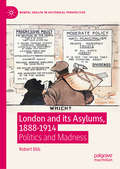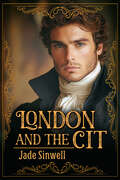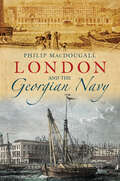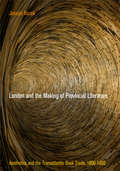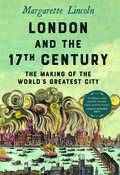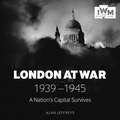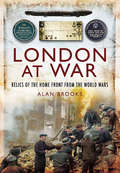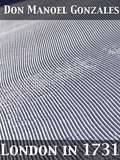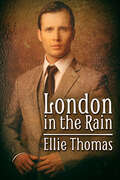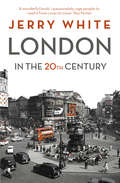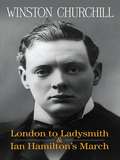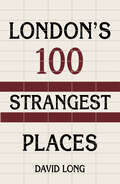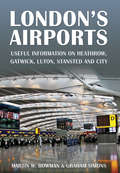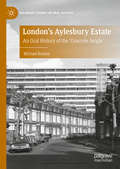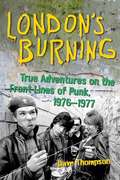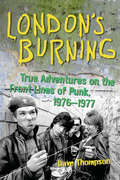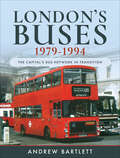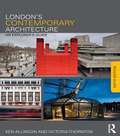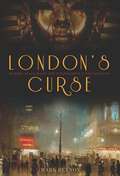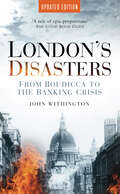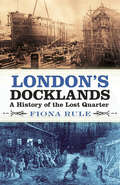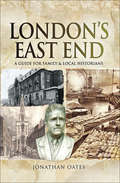- Table View
- List View
London and Paris Through Indian Spectacles
by G. Paramaswaran Pillai Usha SahanaThe book is structured in the form of a series of sketches, usually about people, and it is here that Piliai's powers of observation and human sympathy are most evident. Whether it is his landlady, a policeman, a bus driver, or a waiter, Pillai makes the individual as well as the institution come alive. There is also a wealth of sociological and historical detail which emerges from the travelogue.
London and its Asylums, 1888-1914: Politics and Madness (Mental Health in Historical Perspective)
by Robert EllisThis book explores the impact that politics had on the management of mental health care at the turn of the nineteenth and twentieth centuries. 1888 and the introduction of the Local Government Act marked a turning point in which democratically elected bodies became responsible for the management of madness for the first time. With its focus on London in the period leading up to the First World War, it offers a new way to look at institutions and to consider their connections to wider issues that were facing the capital and the nation. The chapters that follow place London at the heart of international networks and debates relating to finance, welfare, architecture, scientific and medical initiatives, and the developing responses to immigrant populations. Overall, it shines a light on the relationships between mental health policies and other ideological priorities.
London and the Cit
by Jade SinwellIn Regency London, where proper behavior is de rigueur, Sir Rudoph Shaw anything but proper. Born to wealthy parents, he loses everything after his father dies when he is only fourteen years old and, now going by plain Rudy Shaw, he is forced to make his own way on the cruel streets of London.But Rudy’s fortunes are changing. He runs into a childhood friend who pulls him back into the world of the rich and powerful, giving Rudy a second chance at the life he should have had. That is, if Rudy can keep his darkest secrets hidden from the world -- first, that he is only a lowly destitute laborer who has sold his body in the past to put food in his belly and, even more devastating if it is revealed, he prefers men in his bed.Upon Rudy’s debut back into the shining world of well-off Londoners, he learns the man whom he has been having a year-long affair with is none other than the affianced husband to his friend’s cousin. If this secret gets out, Rudy will be ruined for sure. Can the two men stay away from each other? Or will their passion and love destroy them both?
London and the Georgian Navy
by Philip MacDougall Philip MacdougallAt a time when the Royal Navy was the biggest and best in the world, Georgian London was the hub of this immense industrial-military complex, underpinning and securing a global trading empire that was entirely dependent on the navy for its existence. Philip MacDougall explores the bureaucratic web that operated within the wider city area before giving attention to London’s association with the practical aspects of supplying and manning the operational fleet and shipbuilding, repair and maintenance. His supremely detailed geographical exploration of these areas includes a discussion of captivating key personalities, buildings and work. The book examines significant locations as well as the importance of Londoners in the manning of ships and how the city memorialised the navy and its personnel during times of victory. An in-depth gazetteer and walking guide complete this fascinating study of Britain, her capital and her Royal Navy.
London and the Making of Provincial Literature: Aesthetics and the Transatlantic Book Trade, 1800-1850 (Material Texts)
by Joseph RezekIn the early nineteenth century, London publishers dominated the transatlantic book trade. No one felt this more keenly than authors from Ireland, Scotland, and the United States who struggled to establish their own national literary traditions while publishing in the English metropolis. Authors such as Maria Edgeworth, Sydney Owenson, Walter Scott, Washington Irving, and James Fenimore Cooper devised a range of strategies to transcend the national rivalries of the literary field. By writing prefaces and footnotes addressed to a foreign audience, revising texts specifically for London markets, and celebrating national particularity, provincial authors appealed to English readers with idealistic stories of cross-cultural communion. From within the messy and uneven marketplace for books, Joseph Rezek argues, provincial authors sought to exalt and purify literary exchange. In so doing, they helped shape the Romantic-era belief that literature inhabits an autonomous sphere in society.London and the Making of Provincial Literature tells an ambitious story about the mutual entanglement of the history of books and the history of aesthetics in the first three decades of the nineteenth century. Situated between local literary scenes and a distant cultural capital, enterprising provincial authors and publishers worked to maximize success in London and to burnish their reputations and build their industry at home. Examining the production of books and the circulation of material texts between London and the provincial centers of Dublin, Edinburgh, and Philadelphia, Rezek claims that the publishing vortex of London inspired a dynamic array of economic and aesthetic practices that shaped an era in literary history.
London and the Restoration, 1659-1683
by Gary S. De KreyArticulate and restless London citizens were at the heart of political and religious confrontation in England from the Interregnum through the great crisis of Church and state that marked the last years of Charles II's reign. The same Reformed Protestant citizens who took the lead in toppling in toppling the Rump in 1659–60 took the lead in demanding a new Protestant settlement after 1678. In the interval, their demands for liberty of conscience challenged the Anglican order, whilst their arguments about consensual government in the city challenged loyalist political assumptions. Dissenting and Anglican identities developed in specific locales within the city, rooting the Whig and Tory parties of 1679–83 in neighbourhoods with different traditions and cultures. London and the Restoration integrates the history of the kingdom with that of its premier locality in the era of Dryden and Locke, analysing the ideas and the movements that unsettled the Restoration regime.
London and the Seventeenth Century: The Making of the World's Greatest City
by Margarette LincolnThe first comprehensive history of seventeenth-century London, told through the lives of those who experienced it The Gunpowder Plot, the Civil Wars, Charles I&’s execution, the Plague, the Great Fire, the Restoration, and then the Glorious Revolution: the seventeenth century was one of the most momentous times in the history of Britain, and Londoners took center stage. In this fascinating account, Margarette Lincoln charts the impact of national events on an ever-growing citizenry with its love of pageantry, spectacle, and enterprise. Lincoln looks at how religious, political, and financial tensions were fomented by commercial ambition, expansion, and hardship. In addition to events at court and parliament, she evokes the remarkable figures of the period, including Shakespeare, Bacon, Pepys, and Newton, and draws on diaries, letters, and wills to trace the untold stories of ordinary Londoners. Through their eyes, we see how the nation emerged from a turbulent century poised to become a great maritime power with London at its heart—the greatest city of its time.
London at War, 1939-1945
by Philip ZieglerIn 1939, London was not merely the greatest city in the world, it was the most tempting and vulnerable target for aerial attack. For six years it was in the front line of the free world’s battle against Fascism. It endured the horrors of the blitz of 1940 and 1941, the V1s, the V2s. Other cities suffered more intensely; no other city was so consistently under attack for so long a time. This is the story of London at war from 1939 to 1945, or perhaps of Londoners at war--for Philip Ziegler, best known as a biographer, is above all fascinated by the people who found their lives so suddenly and violently transformed: the querulous, tiresome, yet strangely gallant housewife from West Hampstead; the turbulent, left-wing, retired schoolmaster from Walthamstow, always standing up to the authorities; the odiously snobbish middle-class woman from Kensington, sneering at the 'scum' who took shelter in the Underground; the typist from Fulham; the plumber from Woolwich. It was their war every bit as much as it was Churchill’s or the King’s, and this is their story. Through a wealth of interviews and unpublished letters and diaries, as well as innumerable books and newspapers, the author has built up a dazzling portrait of an entire population under siege. There were cowards, there were criminals, there were incompetents, but what emerges from these pages is above all a record, in story after story, of astonishing patience, dignity and humour. 'I hope,' Ziegler writes, 'we will never have to endure again what they went through between 1939 and 1945. I hope, if we did, that we would conduct ourselves as well.'
London at War: 1939-1945 A Nation's Capital Survives
by Alan JeffreysLondon was a city on the front line in the Second World War. It suffered hits from nearly 12,000 tons of bombs, with nearly 30,000 civilians killed by enemy action. The Blitz changed the landscape of the city. Many famous landmarks were hit, including Buckingham Palace, the Houses of Parliament, the Tower of London - even the Imperial War Museum. Some areas, such as Stepney, were so badly damaged that they had to be almost entirely rebuilt after the war. But it wasn't just the city's physical landscape that was transformed. With the arrival of large numbers of Commonwealth and overseas service personnel, London became much more cosmopolitan. After 1942, vast numbers of American servicemen were deployed in the capital, and it was also a busy transport hub and a popular destination for troops on leave.This audiobook tells the story of these momentous years in London's history through IWM's unique collections. Using personal accounts from letters and diaries, objects and documents it gives an up-close and revealing insight into those turbulent years in the capital, experienced by those who lived there.(P)2021 Headline Publishing Group Limited
London at War: Relics of the Home Front from the World Wars
by Alan BrooksAn extensively illustrated tour of relics and reminders of the city&’s WWI and WWII experiences. The two world wars of the twentieth century seem so distant from us now, yet in London the evidence of these conflicts can be found in the many relics and reminders that are scattered across the fabric of the modern city. And, as Alan Brooks demonstrates in this fascinating photographic record, they can be seen and visited today. Plaques and inscriptions, graves, cemeteries and rolls of honor, stone monuments and stained glass, war-damaged buildings, pillboxes, and air-raid shelters, painted signs and camouflage—these are just some of the mementos of war, and of the experience of Londoners during the greatest conflicts the country has known.
London in the Rain
by Ellie ThomasA life of set routine is the norm for Raymond Smith. Now in his mid-thirties, a fleeting wartime romance far behind him, he is an exemplary clerk at a London insurance firm where he’s perceived as dry and conventional.But Raymond has a secret. Every month or so, he visits Charlie’s, one of the more understated bars in Soho's flowering gay scene in the 1930s. There, he seeks relief with strangers to get him through the next few weeks.On one of these visits, he encounters suave David Carstairs, a well-travelled linguist with the Foreign Office. Rather than a brief encounter, David offers him friendship and even affection. Despite Raymond’s misgivings, the two men, with their contrasting backgrounds and experiences, start to form a bond in the spring of 1936 as Europe inexorably begins to march towards war.Will Raymond fearfully reject this chance of happiness? Or can he unbend enough to allow David into his heart and life?
London in the Twentieth Century: A City and Its People
by Jerry WhiteJerry White's London in the Twentieth Century, Winner of the Wolfson Prize, is a masterful account of the city’s most tumultuous century by its leading expert.In 1901 no other city matched London in size, wealth and grandeur. Yet it was also a city where poverty and disease were rife. For its inhabitants, such contradictions and diversity were the defining experience of the next century of dazzling change.In the worlds of work and popular culture, politics and crime, through war, immigration and sexual revolution, Jerry White’s richly detailed and captivating history shows how the city shaped their lives and how it in turn was shaped by them.
London to Ladysmith & Ian Hamilton's March
by Winston ChurchillIn addition to his enduring fame as a statesman, Winston Churchill was a Nobel Prize-winning author whose military histories offer the unique perspective of a participant in world affairs. London to Ladysmith and Ian Hamilton's March reflect his early career as a Boer War correspondent for London's Morning Post in 1899 and 1900. London to Ladysmith chronicles the Boer War's first five months, from the author's arrival in South Africa to his capture during a Boer ambush of an armored train. Churchill's gripping narrative of his escape from a prisoner-of-war camp traces a grueling journey across enemy territory and back to British lines. Ian Hamilton's March picks up the action immediately afterward, documenting the eponymous general's 400-mile advance from Bloemfontein to Pretoria. The march saw ten major battles and numerous skirmishes, culminating in the release of prisoners from the camp where Churchill himself was held. Written mostly in the field, this book offers a vivid, personal account of the conditions under which the Boer War was fought, as well as a fascinating look at the formative years of one of the twentieth century's preeminent leaders.
London's 100 Strangest Places: London's 100 Strangest Places
by David LongThe bustling metropolis of London is home to scores of unusual and unique places and spaces. In this feast of peculiarities, author David Long guides you off the beaten path and allows you under the skin of the hidden city that is modern-day London, revealing a new side to the capital you thought you knew.
London's Airports: Useful Information on Heathrow, Gatwick, Luton, Stansted and City
by Martin W. Bowman Graham M. SimonsThis book is for the passengers and aviation buffs who use Londons main airports. It includes a brief history, plans and photographs for each of the five airports, together with directions and information about gates, security, passport control, shopping, restaurants, car parks and other transport connections. Details of Air Traffic Control in London airspace is explained with the inclusion of aerial photographs taken during approach to landing so passengers may locate places of interest whilst flying.
London's Aylesbury Estate: An Oral History of the 'Concrete Jungle' (Palgrave Studies in Oral History)
by Michael RomynThis book looks beyond the Aylesbury’s public face by examining its rise and fall from the perspective of those who knew it, based largely on the oral testimony and memoir of residents and former residents, youth and community workers, borough Councillors, officials, police officers and architects. What emerges is not a simple story of definitive failures, but one of texture and complexity, struggle and accord, family and friends, and of rapidly changing circumstances. The study spans the years 1967 to 2010 – from the estate’s ambitious inception until the first of its blocks were pulled down. It is a period rarely dealt with by historians of council housing, who have typically confined themselves to the years before or after the 1979 watershed. As such, it demonstrates how shifts in housing policy, and broader political, economic and social developments, came to bear on a working-class community – for good and, more especially, for ill.
London's Burning: True Adventures on the Front Lines of Punk, 1976-1977
by Dave ThompsonLondon's Burning is the story of punk rock as it happened, stripped of hindsight and future legend, and laid bare. Here are the Damned and the Adverts on tour, the Sex Pistols swearing through their prime-time television debut, the Tom Robinson Band conducting a club full of skinheads through the anthem "Glad to Be Gay," rioting Rastas running through the carnage that closed the Notting Hill Carnival, Sid Vicious arguing about which was David Bowie's best song. At the same time, it is a personal story of a confused but dedicated sixteen-year-old looking not just for kicks and great music, but for a cultural revolution--and finding one in his back yard.
London's Burning: True Adventures on the Front Lines of Punk, 1976–1977
by Dave ThompsonThe summer of 1976 through the summer of 1977 was the most significant year in British rock history, when punk rock rose from a murmur on the streets to a roar of defiance that still reverberates today. This collection of vivid memories of concerts and cultural flash points focuses on what was happening on the streets and in the clubs, answering questions like What brought punks together with London's disenfranchised Rasta community? What made Teddy Boys--middle-aged men who dressed like 1950s rockers--hate punks so much that they roamed in packs looking for teenagers to beat up? What was it like to be in the now legendary Roxy Club? and Were the Sex Pistols really any good as a live band? Memories from others who were there--including members of the Damned, the Adverts, the Patti Smith Group, the Maniacs, and the Tom Robinson Band--add to this story of punk rock as it happened, stripped of hindsight and future legend, and laid bare.
London's Buses, 1979–1994: The Capital's Bus Network in Transition
by Andrew BartlettIn 1979, fresh from its general election victory, the Conservative government began formulating plans to deregulate bus services and privatise the companies operating them in England, Scotland and Wales. London was not to be excluded, so from the outset, London Buses was broken up into several areas and from 1985, a tendering system was introduced which permitted other operators to bid for the routes. Opposition from the Labour group at the Greater London Council had to be dealt with – eventually achieved by abolishing it in 1986. However, as each subsequent year passed, promises that deregulation was coming were not met. In late 1992, the privatisation timetable was set, and was ultimately completed at the end of 1994. The issue of deregulation never resurfaced. Copiously illustrated with over 270 photographs, virtually all of which are being published for the first time, this is the story of London Buses over those sixteen tumultuous years. To give greater context to the narrative, annual vehicle acquisition listings show how purchasing policy changed over the period; important route changes, tendering gains and losses and a fleet list for the entire period are also included.
London's Contemporary Architecture: An Explorer's Guide
by Ken Allinson Victoria ThorntonLondon is a living architectural exhibition. This tried and trusted portable guide will help you to find your way around one of the world’s most exciting cities, offering architectural experiences and insights into London’s finest contemporary architecture. features more than 400 buildings including key venues from the 2012 Olympic Park provides a superb full colour photographic record of the capital aids navigation of the city’s greatest architectural sights with a clear map-based format considers each district in turn, identifying the buildings most worthwhile visiting, and providing essential information and insights into each includes a large scale, portable, lightweight map, for use when walking the tours Jam packed with the author’s intimate architectural experience and knowledge of London’s buildings, the accompanying commentary is both lively and entertaining, providing all the information that any architectural explorer will need to appreciate and experience London’s contemporary architecture.
London's Curse: Murder, Black Magic and Tutankhamun in the 1920s West End
by Mark BeynonThroughout the 1920s and 1930s, London was gripped by the supposed curse of Tutankhamun, whose tomb in the Luxor sands was uncovered in February 1923 by the British archaeologist Howard Carter. The site was plundered, and over the next few years more than twenty of those involved in the exhumation or in handling the contents of the tomb perished in strange and often terrifying circumstances, prompting the myth of the 'Curse of Tutankhamun'. Nowhere - particularly London's West End - appeared to be safe for those who had provoked the ire of the Egyptian death gods. A blend of meticulous research and educated conjecture, historian and screenwriter Mark Beynon turns armchair detective as he uncovers a wealth of hitherto unpublished material that lays bare the truth behind these fatalities. Could 'London's Curse' be attributed to the work of a macabre mastermind? It soon becomes apparent that these deaths were not only linked by the ominous presence of Tutankhamun himself, but also by a murderer hell-bent on retribution and dubbed by the press as 'The Wickedest Man in the World'.
London's Disasters: From Boudicca to the Banking Crisis
by John WithingtonFrom AD 61, when Queen Boudicca – outraged at her treatment at the hands of the Romans – marched on the city and burned it to the ground, London has been hit by wave upon wave of destruction. This fascinating and unique book tells the story of over 2000 years of disaster – fire, water, disease, pollution, accident, storm, riot, terrorism and enemy action. It chronicles well-known episodes like the Great Plague of 1665 and the Blitz, as well as lesser-known events such as whirlwinds and earthquakes. This new edition also includes the recent terrorist attack on 7 July 2005, as well as a new section on the crises which have plagued the financial City, including the near-collapse of Britain’s banks during 2008 and 2009. London’s Disasters ultimately celebrates the spirit of the people of London who have risen above it all and for whom London is still a great city in which to live and work.
London's Docklands: A History of the Lost Quarter
by Fiona RuleDo you remember the docks? In its heyday, the Port of London was the biggest in the world. It was a sprawling network of quays, wharves, canals and basins, providing employment for over 100,000 people. From the dockworker to the prostitute, the Romans to the Republic of the Isle of Dogs, London’s docklands have always been a key part of the city. But it wasn’t to last. They might have recovered from the devastating bombing raids of the Second World War – but it was the advent of the container ships, too big to fit down the Thames, that would sound the final death knell. Over 150,000 men lost their jobs, whole industries disappeared, and the docks gradually turned to wasteland. In London’s Docklands: A History of the Lost Quarter, best-selling historian Fiona Rule ensures that, though the docklands may be all but gone, they will not be forgotten.
London's East End: A Guide for Family & Local Historians
by Jonathan OatesThe East End is one of the most famous parts of London and it has had its own distinctive identity since the district was first settled in medieval times. It is best known for extremes of poverty and deprivation, for strong political and social movements, and for the extraordinary mix of immigrants who have shaped its history. Jonathan Oatess handbook is the ideal guide to its complex, rich and varied story and it is an essential source for anyone who wants to find out about an East End ancestor or carry out their own research into the area.He outlines in vivid detail the development of the neighbourhoods that constitute the East End. In a series of information-filled chapters, he explores East End industries and employment the docks, warehouses, factories, markets and shops. He looks at its historic poverty and describes how it gained a reputation for criminality, partly because of notorious criminals like Jack the Ripper and the Krays. This dark side to the history contrasts with the liveliness of the East End entertainments and the strong social bonds of the immigrants who made their home there Huguenots, Jews, Bangladeshis and many others.Throughout the book details are given of the records that researchers can consult in order to delve into the history for themselves online sites, archives, libraries, books and museums.

